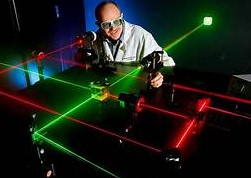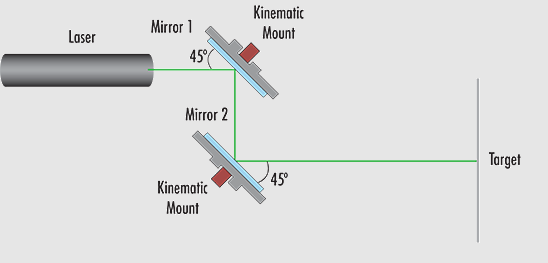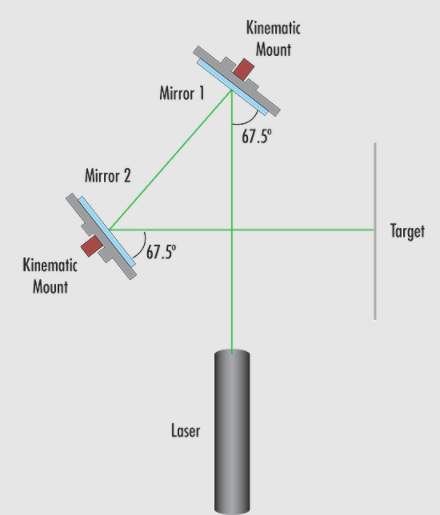
Laser alignment is critical for applications like spectroscopy, holography, and optical system integrations, but achieving a precise beam path can be challenging, especially with invisible wavelengths. Helium-neon (HeNe) lasers, with their superior beam quality and visible wavelengths, simplify this process. This article explores HeNe laser technology, alignment techniques, and key considerations for selecting the right HeNe laser, highlighting RPMC Laser’s solutions for professionals.
Understanding HeNe Lasers for Alignment
A helium-neon (HeNe) laser is a continuous-wave (CW) gas laser using a 10:1 helium-neon mixture pressurized in a glass tube. When a DC current excites helium atoms into metastable states, they transfer energy to neon atoms, enabling multiple laser transitions.
Visible Wavelength Versatility for Optical Alignment
The most common HeNe wavelength is 632.8 nm (red), ideal for visible alignment due to high eye sensitivity compared to longer red wavelengths (e.g., 690 nm). Other options include 543.5 nm (green), which allows for the best visibility even in well-lit environments, and 594 nm (yellow) wavelengths. Modern HeNe lasers are compact (15–50 cm tube length), offer 0.5–20 mW output, and provide excellent TEM00 beam quality.
For more background & critical considerations when choosing a HeNe laser, see our article:
“HeNe Lasers: Fundamentals, History & Key Considerations When Selecting”.
Why HeNe Lasers Excel in Laser Alignment
HeNe lasers are preferred for alignment due to their visible wavelengths and superior beam characteristics, simplifying the process compared to infrared lasers or diodes.
Visible Wavelengths for Enhanced Visibility

Aligning invisible infrared beams is challenging, but HeNe’s visible wavelengths (e.g., 632.8 nm red, 543.5 nm green) allow technicians to actively visualize the beam path. As mentioned above, shorter wavelengths (e.g., 630 nm vs. 690 nm), especially green wavelengths, offer better visibility in ambient light. However, some optical components may cause alignment issues when using specific wavelengths due to various wavelength-dependent dielectric coatings on optical lenses and other chromatic aberrations. Typically, these issues are only seen in optical lenses and not on reflecting mirrors. So, if your system involves optical lenses, be sure to note any conflicts with your lens coatings or substrate composition and the visible wavelengths you might use to align the optical system.
Superior Beam Quality vs. Laser Diodes
Unlike laser diodes, which produce elliptical, astigmatic, and divergent beams requiring corrective optics, HeNe lasers deliver inherently Gaussian, circular beams with minimal divergence. This makes them ready for alignment without additional shaping, ensuring precision in applications like optical system setup.
Key Laser Alignment Techniques Using HeNe Lasers
Effective alignment requires proper techniques and tools. Below are two common configurations using HeNe lasers to achieve precise beam paths.
Parallel Z-Fold Configuration for Compact Alignment
The Parallel Z-Fold configuration uses two kinematic mirror mounts at ≈45° angles to redirect the beam 90 degrees, ideal for tight spaces. Adjust Mirror 1 to position the beam on Mirror 2 in the X- and Y-axes, then adjust Mirror 2 for angular displacement to hit the target. Using reference points (e.g., a crosshair reticle or card with an ‘X’/’+’) at Mirror 2 and the target ensures parallel alignment to the table. Replace mirrors with dichroic filters for multi-wavelength setups.
Figure-4 Configuration for Perpendicular Beams
The Figure-4 configuration, using two mirrors at 67.5° angles, aligns the beam perpendicular to the source in a compact footprint. Adjust Mirror 1 for X- and Y-positioning and Mirror 2 for angular alignment to the target. Reference points at Mirror 2 and the target streamline adjustments, making this ideal for constrained setups.
Considerations for Selecting HeNe Lasers for Alignment
Choosing the right HeNe laser for alignment involves evaluating beam quality, stability, and integration options to match your setup’s needs.
1. Beam Collimation and Pointing Stability
A collimated beam with minimal divergence ensures consistent diameter over the beam path, critical for accuracy. HeNe lasers offer excellent pointing stability (e.g., 0.03 mrad, or 3 mm drift over 100 m), minimizing angular displacement from thermal expansion or mechanical shock.
RPMC Solution: Our HeNe lasers provide low divergence and high pointing stability, ideal for precise alignment in spectroscopy and interferometry.
2. Wavelength Selection for Visibility and Compatibility
Choose visible wavelengths like 632.8 nm for high visibility or 543.5 nm and 594 nm for specific alignment tasks. Ensure compatibility with optical components to avoid wavelength-dependent issues.
RPMC Solution: RPMC’s HeNe lasers offer 632.8 nm, 543.5 nm, and 594 nm options, tailored for visible alignment applications.
3. Robust Design and Mounting Options
HeNe lasers’ rigid, cylindrical bodies ensure stable mounting in V-block or optical post assemblies on alignment tables. A two-pinhole jig can enhance repeatability for complex setups.
RPMC Solution: Our HeNe lasers feature robust mechanical designs, perfect for repeatable alignment in lab or OEM systems.
4. Laser Safety for Alignment
Always use proper laser safety goggles rated for your wavelengths, post warnings, and secure the beam path to prevent accidents during alignment.
RPMC Guidance: Contact us at [email protected] for safety and alignment recommendations to ensure safe, effective setups.
Why Choose RPMC’s HeNe Lasers for Alignment?
HeNe lasers remain unmatched for alignment due to their Gaussian beam, low divergence, and long service life (up to 30,000 hours). RPMC, in partnership with LASOS, offers HeNe lasers in 632.8 nm, 543.5 nm, and 594 nm, with output powers of 0.5–20 mW. Customizable options include single-mode or multimode, random or linear polarization, Brewster window tubes, and fiber coupling, with laboratory or OEM power supplies. These lasers excel in spectroscopy, holography, interferometry, and optical alignment.
Ready to Align with HeNe Lasers?
Selecting the right HeNe laser ensures precise, efficient alignment for your optical system. RPMC’s HeNe lasers, available in 632.8 nm, 543.5 nm, and 594 nm, deliver superior beam quality and stability. Contact our team at [email protected] or click below to discuss your alignment solutions.
Have questions?

 BUY NOW
BUY NOW 


